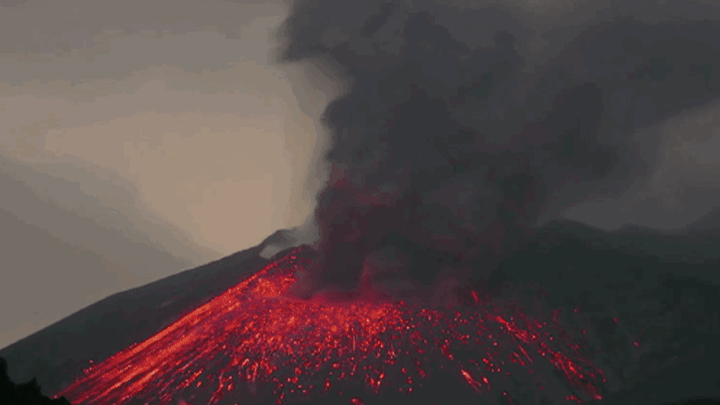Recently, a viral video of rare volcanic lightning footage has been making the rounds on social media. It’s easy to see why. The dramatic clip appears to show flecks of lightning dancing though an ominous volcanic plume, the likes of which most viewers have never seen. Make that all viewers, actually: As it turns out, the clip was actually doctored by the BBC, which combined footage from two separate eruptions for a scene in their hit series Patagonia: Earth’s Secret Paradise.
Nonetheless, volcanic lightning—a phenomenon that’s also known as a “dirty thunderstorm”—is still very real. Here’s what the incredible display actually looks like:
Back in March, German photographer Marc Szeglat captured the spectacle above, which is the Sakurajima volcano, located on Kyushu, Japan’s third-largest island. (Before 1914, the volcano sat on a smaller island named Sakurajima, but a huge eruption that year merged the landmass with Kyushu proper.)
A seasoned volcano photographer, Szeglat set out to document a Sakurajima blast and, in the process, also captured one of nature’s most mysterious wonders. At 2:05 in the video, you can see a lightning bolt zig-zagging across the eruption’s ashy mushroom cloud.
What’s going on here? Believe it or not, some volcano-generated plumes are capable of creating powerful electrical charges that can lead to streaks of lightning, and bolts as large as two miles long.
As Szeglat explained to the BBC, “In a normal thunderstorm ice crystals collide and generate electrical charges, which results in lightning. In an eruption cloud, ash particles collide instead of ice crystals.”
But how do these particle collisions actually produce lightning? Experts aren’t entirely sure. “How lightning forms in general is still debated among scientists,” writes geologist Brentwood Higman on Geology.com, “and volcanic lightning is even less well understood.”
Still, we can say with reasonable certainty that all dirty thunderstorms require what’s known as a pyroclastic flow—fast-moving volcanic currents consisting of hot gas, rock fragments, and ash. They’re also incredibly dangerous, as the billowing clouds tend to “hug” the ground and bury everything in their path. Such flows famously descended upon Pompeii in 79 CE, while others surged forth from Mount St. Helens during its sky-darkening 1980 eruption.
As tiny particles are kicked into the atmosphere, they begin to move apart or split in two. The positively charged particles separate from their negatively charged brethren, and eventually build up enough attraction to cause a serious spark. According to Higman, “Lightning is the electrical flow that results when this charge separation becomes too great for air to resist the flow of electricity.”
Well-documented dirty thunderstorms broke out at Mount Redoubt of Alaska in 2009 and Iceland’s Eyjafjallajökull in 2010. Masses of round, glassy beads were later discovered at both sites, and earlier this year, an international scientific team concluded that the spherules had been forged by volcanic lightning. In theory, the incredibly hot bolts (whose scalding temperatures can reach 30,000°C) melted down pieces of ash which then re-solidified as little glass balls.
Recent research also suggests that volcanic lightning bolts come in at least two distinct types. Some—like these—dart about near the tops of plumes. Meanwhile, others simply hang around the volcano’s mouth.
Volcanic lightning storms can also demonstrate the kind of intensity that’s normally reserved for Midwestern tempests. Unfortunately, filming them in action has proven exceptionally difficult, with flashes of lightning being too quick for most recording devices. So while the BBC did embellish that footage, it's likely that a "super-charged volcanic ash cloud" (!) could really be that spectacular—we'd just have to record it first to see.
